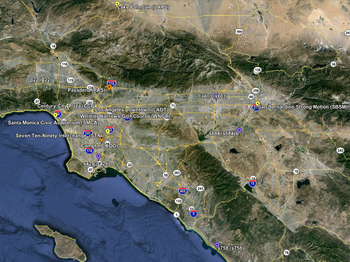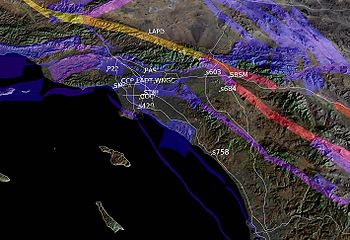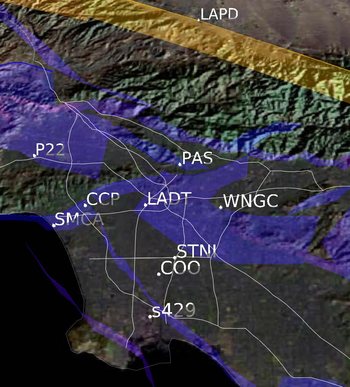Difference between revisions of "Moved:CyberShake MCER"
| Line 33: | Line 33: | ||
*GMPE 2008 GMRotI50 to RotD100 conversion factors: See spreadsheet | *GMPE 2008 GMRotI50 to RotD100 conversion factors: See spreadsheet | ||
*GMPE 2014 RotD50 to RotD100 conversion factors: See spreadsheet | *GMPE 2014 RotD50 to RotD100 conversion factors: See spreadsheet | ||
| + | |||
| + | === Disaggregation Plots === | ||
| + | |||
| + | We disaggregated the CyberShake and NGA hazard curves at 3 seconds and plotted the top 10 contributors for each site. These plots are available here: [http://hypocenter.usc.edu/research/cybershake/11_14_UGMS_Meeting/hazard_decomposition_plots.zip Disaggregation Plots] | ||
| + | |||
| + | === Background Seismicity Plots === | ||
| + | |||
| + | To determine the impact of background seismicity, we calculated the contributions of on-fault and background seismicity to the NGA hazard curves. These plots are available here: [http://hypocenter.usc.edu/research/cybershake/11_14_UGMS_Meeting/back_seis_contribution_plots.zip Background Seismicity Contribution Plots] | ||
| + | |||
== Deterministic MCER Results == | == Deterministic MCER Results == | ||
| Line 70: | Line 79: | ||
# NGA (2014): lower of probabilistic MCER and (higher of deterministic and ASCE deterministic lower limit). | # NGA (2014): lower of probabilistic MCER and (higher of deterministic and ASCE deterministic lower limit). | ||
# ASCE 7-10 Ch 11.4 | # ASCE 7-10 Ch 11.4 | ||
| − | |||
| − | |||
| − | |||
| − | |||
Revision as of 22:23, 28 October 2014
For the Utilization Committee meeting on November 3, 2014, we are preparing probabilistic and deterministic MCER results using the CyberShake dataset.
Contents
Meeting
November 3, 2013 meeting agenda is available here.
Study Sites
We are calculating MCER results for 14 sites, available in a KML file Image to the right shows the location of the MCER 2014 study sites. These sites can be plotted using the following KML file:
- MCER 2014 Study Sites (Google Earth KML Format). (KML file)
Near surface information about these sites includes Vs30, Z1.0, Z2.5 Values. These values are used in GMPE calculations for these sites. Site names, locations, and near surface values are listed in the following file.
- Site List with Vs30 Information (CSV File)
Probabilistic MCER Results
CyberShake probabilistic MCER results for the 14 sites. This also contains comparable RotD100 results for the 2008 and 2014 NGAs.
- Probabilistic MCER Results. (Excel xlsx file)
This zip file contains pseudo spectral velocity plots for the probabilistic results.
- Probabilistic MCER Plots. (815Kb Zip File containing PNG images)
Metadata for these results include:
- CyberShake Model: Study 14.2
- Velocity Model: CVM-S4.26
- Earthquake Rupture Forecast: UCERF2
- Rupture Generator: GP 2010
- Background Seismicity: None
- RotD100 Software: Modified BBP RotD50
- GMPE 2008 GMRotI50 to RotD100 conversion factors: See spreadsheet
- GMPE 2014 RotD50 to RotD100 conversion factors: See spreadsheet
Disaggregation Plots
We disaggregated the CyberShake and NGA hazard curves at 3 seconds and plotted the top 10 contributors for each site. These plots are available here: Disaggregation Plots
Background Seismicity Plots
To determine the impact of background seismicity, we calculated the contributions of on-fault and background seismicity to the NGA hazard curves. These plots are available here: Background Seismicity Contribution Plots
Deterministic MCER Results
CyberShake deterministic MCER results for the 14 sites, along with comparable results for the 2008 and 2014 NGA models.
- Deterministic MCER Results. (Excel xls file)
This zip file contains pseudo spectral velocity plots for the deterministic results.
- Deterministic MCER Plots. (850Kb zip file containing PNG images)
Metadata for these results include:
- CyberShake Model: Study 14.2
- Velocity Model: CVM-S4.26
- Earthquake Rupture Forecast: UCERF2
- Rupture Generator: GP 2010
- Background Seismicity: None
- RotD100 Software: Modified BBP RotD50
- GMPE 2008 GMRotI50 to RotD100 conversion factors: See probabilistic spreadsheet
- GMPE 2014 RotD50 to RotD100 conversion factors: See probabilistic spreadsheet
Combined MCER Plots
From the probabilistic and deterministic results, we have produced combined MCER plots of two types, both plotting PSV at periods from 1-10 sec, using the probabilistic and deterministic results previously calculated for the 14 sites identified by the Utilization Committee.
Type A contains 5 curves for each site and are available in a zip file here: All combined plots (~400KB zip file containing PDF, PNG, and TXT files)
- average of the probabilistic NGAs (2014) without Idriss. This was obtained by averaging the 4 NGA hazard curves, then convolving with the fragility function.
- average of the deterministic NGAs (2014) without Idriss
- probabilistic MCER for Cybershake
- deterministic Cybershake
- ASCE 7-10 Det Lower Limit
Type B contains 3 curves for each site and are available in a zip file here: MCER combined plots (~300KB zip file containing PDF, PNG, and TXT files)
- CyberShake: lower of probabilistic MCER and (higher of deterministic and ASCE deterministic lower limit). For CyberShake, the probabilistic is always lower than the deterministic.
- NGA (2014): lower of probabilistic MCER and (higher of deterministic and ASCE deterministic lower limit).
- ASCE 7-10 Ch 11.4


